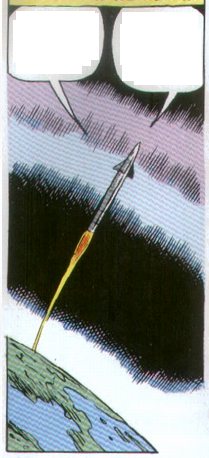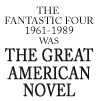







 |
 |
 |
 |
 |
 |
 |
 |
Jack Kirby wrote Challengers of the Unknown until issue 8. His story continues in Fantastic Four issue 1.
First I will look at the similarities, then at what Jack Kirby intended, and then how they are the same characters,
The Challengers and the FF are a team of four adventurers who explore
the unknown. Here is the first view we get of each team: even the
design is the same
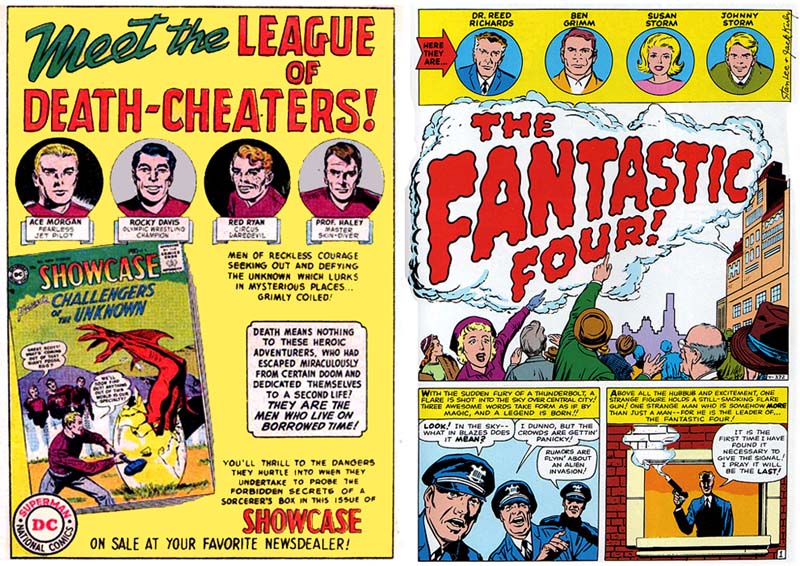
Both series begins with four friends surviving a plane crash (or rocket crash) and then dedicating their lives to doing good.
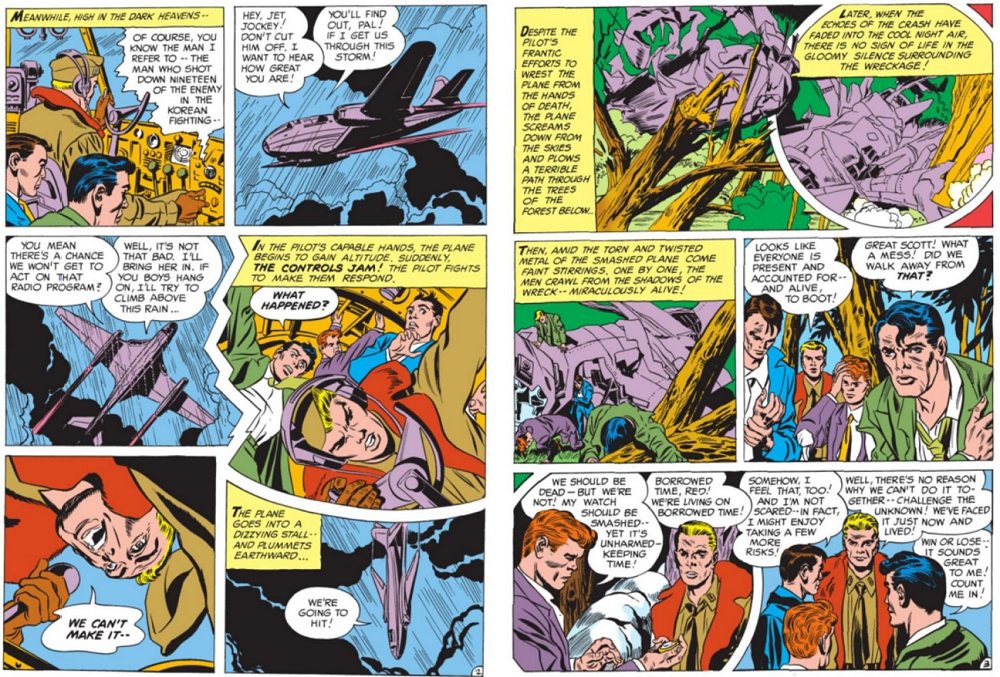
The first crash made them friends, the second crash gave them powers.
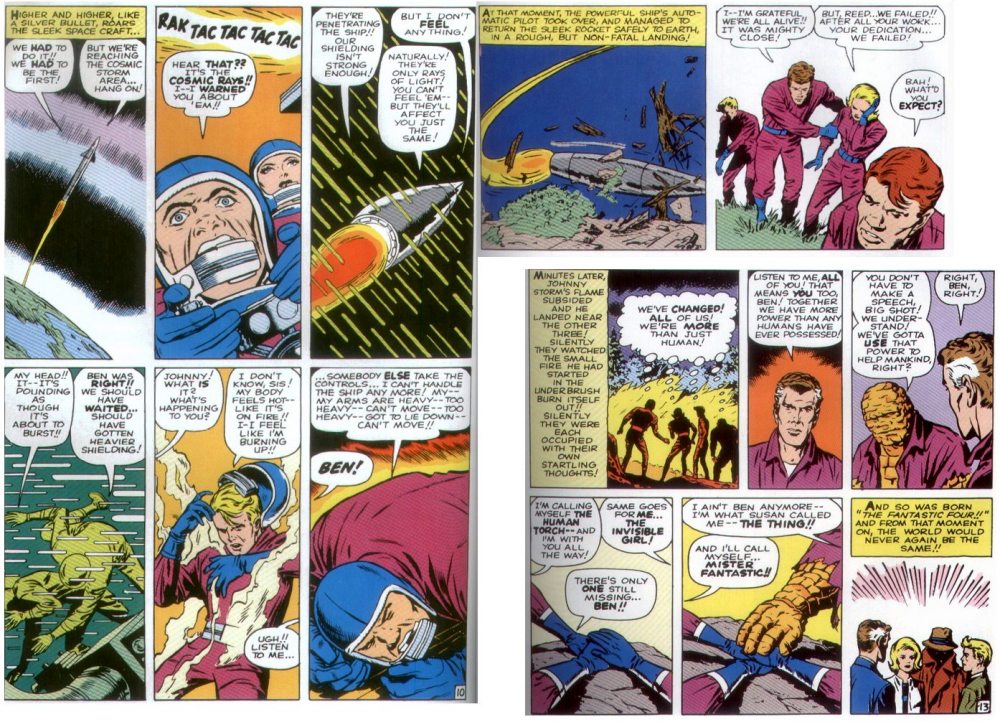
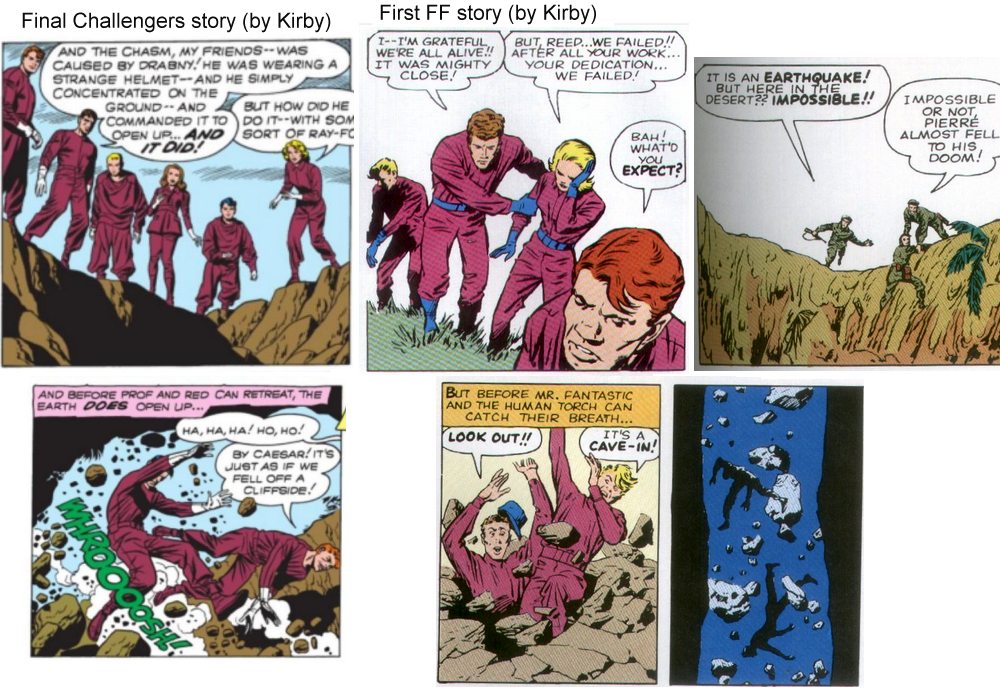
In the early years, the Challengers/FF headquarters looked the same. They even stood in the same poses!

The first Challengers story is about mind control: the giant is in the mind, and the energy globe communicates in the mind. In the next issue, the giant robot communicates and controls through the mind. Fanastic Four 3 is about mind control and another red monster who is defeated when they realise he is all in the mind. Fantastic Four 7 and 8 also rely on mind control.
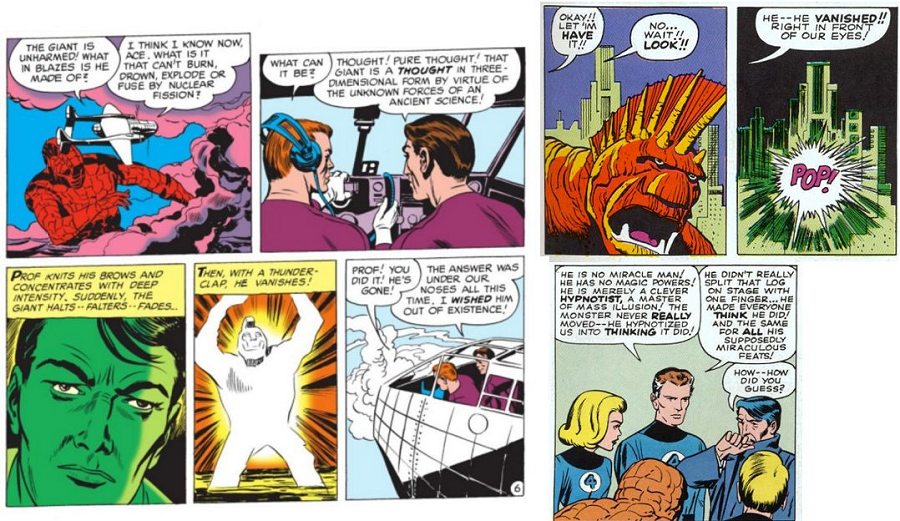
Their main enemy is a sorcerer...
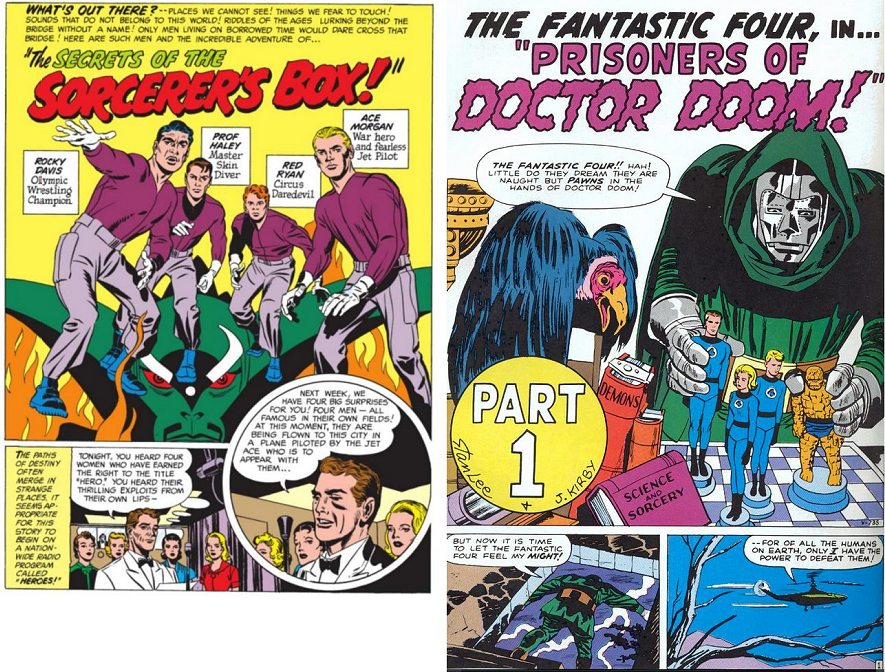
...who wears a hooded cloak, and possesses incredible inventions.
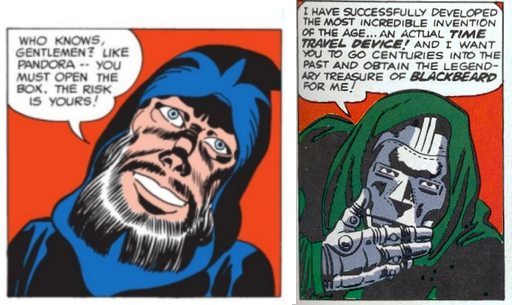
He lives in a castle... in America!
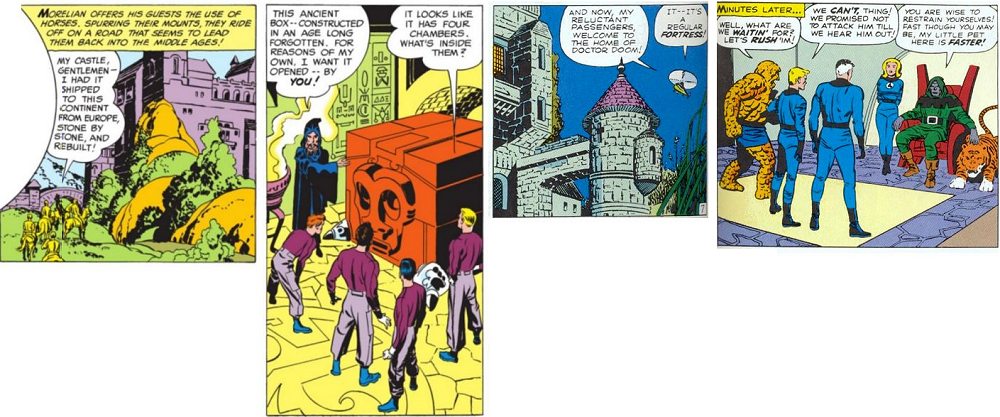
.He is associated with Merlin, and his goal is to obtain magical jewels that make him immortal or invincible:
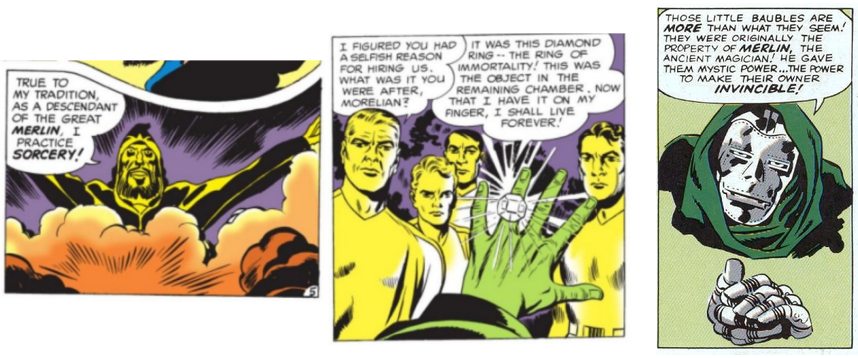
The Challengers/FF visit outer space, underground, under the oceans, and every other exotic location. The first Challengers story has then fly to a remote island where they find a monster. The first Fantastic Four story has them fly to Monster Island.
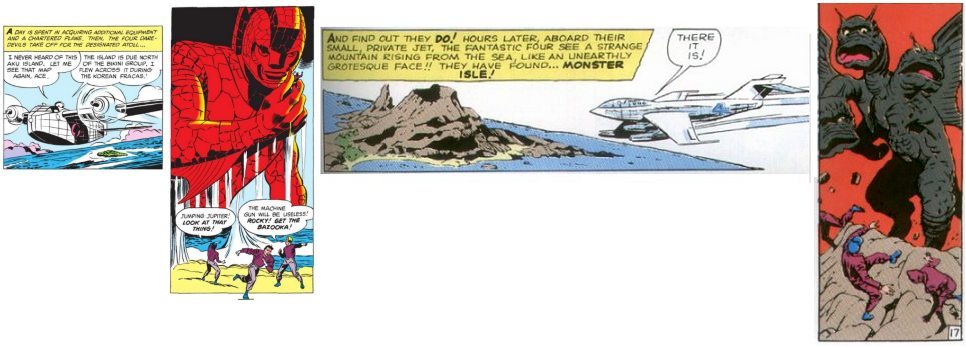
We see the same advanced technology in each: from the radically redesigned helicopter...

..to the aliens falling in low gravity in order to reach their underground city:
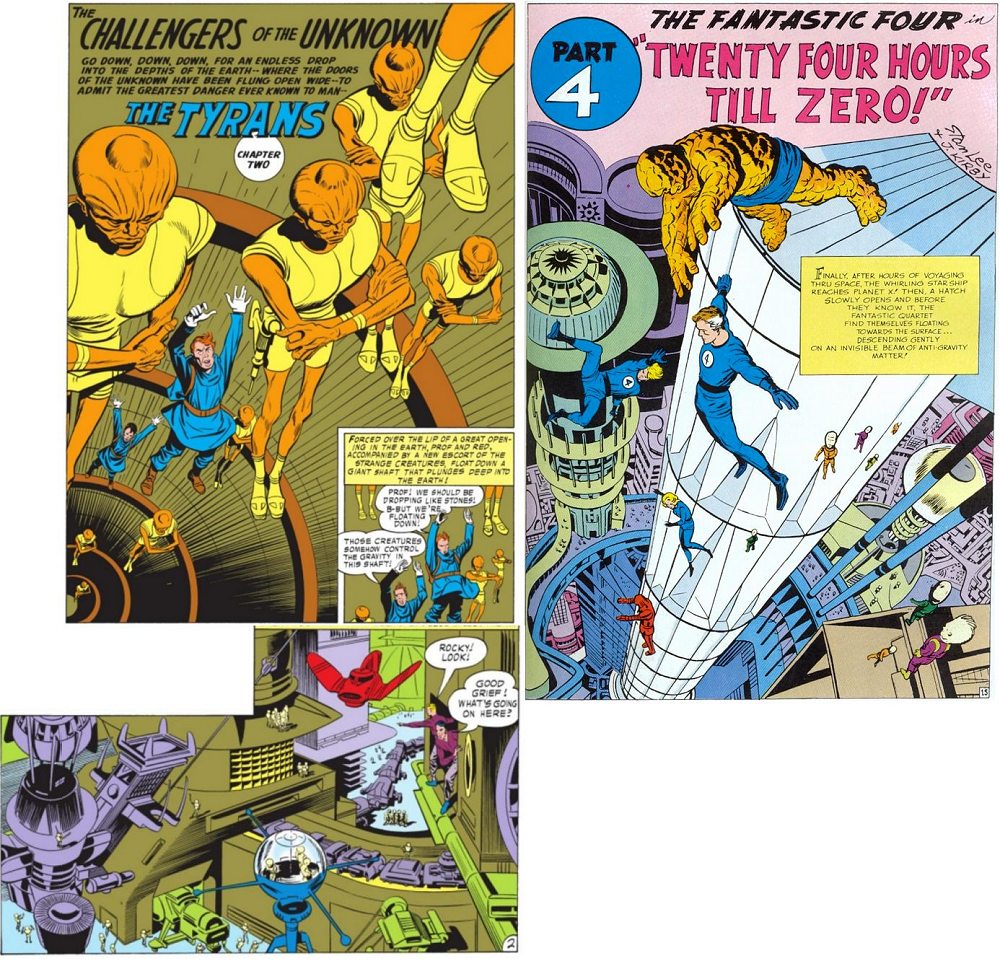
In Challengers 3, Rocky gains the powers associated with the Fantastic
Four: flame, invisibility, changing his body size, and great strength.
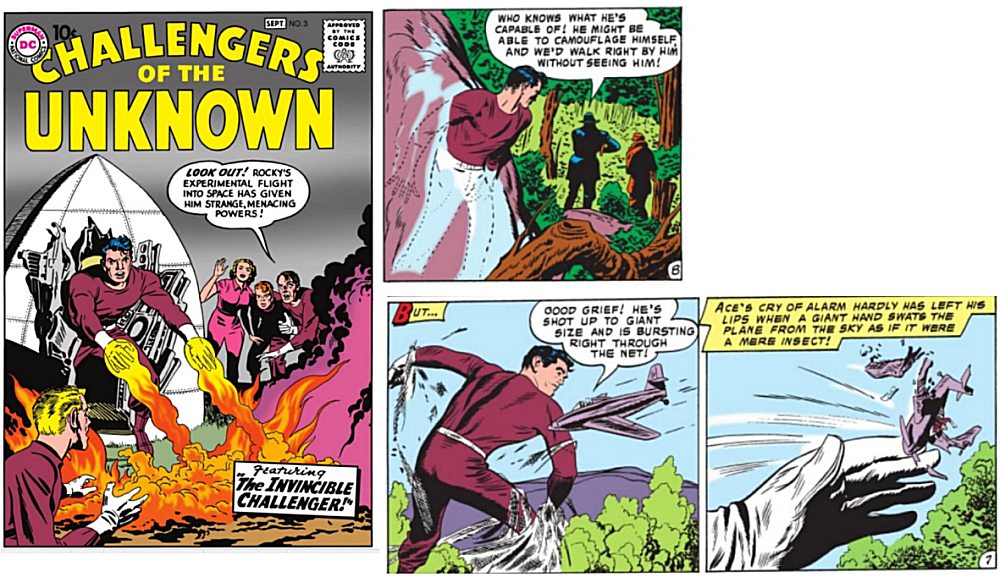
(The small print: Although Mr Fantastic is thought of as stretching, not growing, he actually changes volume. He just chooses to enlarge or reduce only sections of his body. And whereas in Rocky's example we might think his strength comes from his size, a being that large would not even be able to stand up. So strength is part of it.)
The Challengers exist to challenge the unknown. So it is natural that the rest of them would explore gaining the same powers. And they do, in Fantastic Four issue 1.
Something about Rocky's trip must have been extremely painful or
distressing. Because when he came back he violently attacked anybody
associated with taking him into space: not just "Ace" (the example
above) and the professor (below), but also the men involved in the space
programme.
However, he did not attack ordinary people, or June, who was not directly involved in causing what happened:
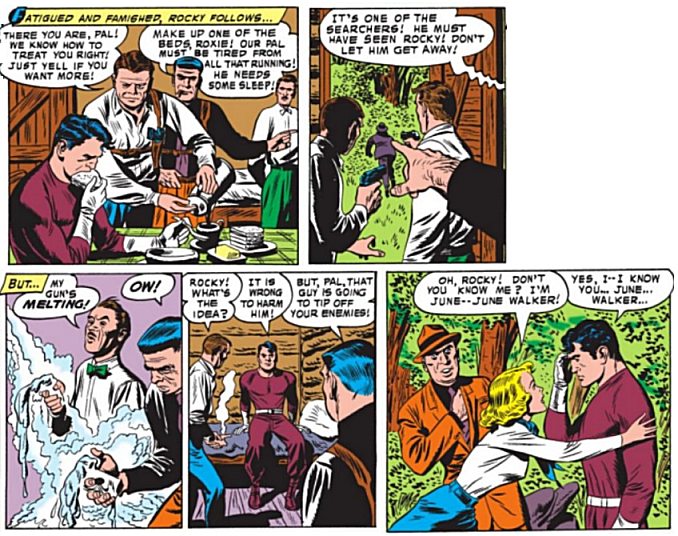
We can explain this as a kind of madness, or of him losing his memory. But that is just opinion. All we know for sure is that the exact same thing happened
in the Fantastic Four. Here I have removed Stan Lee's dialog,
so we can more clearly see Kirby's intent:
changing makes the men angry and violent.
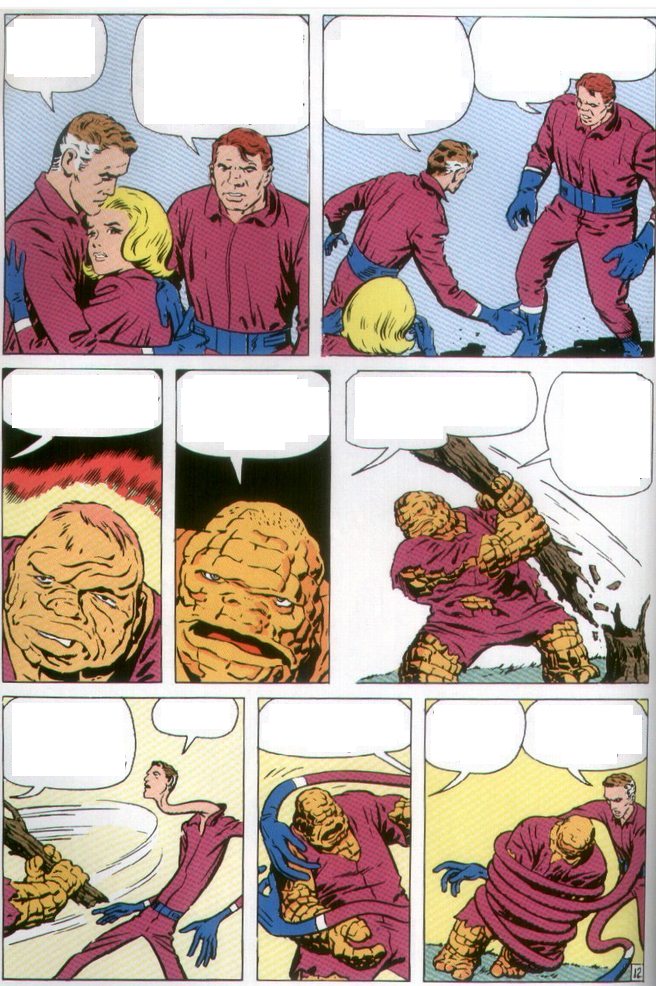
The alien process gave them whatever powers they needed at the time. Ben wanted to hit Reed, and Reed wanted to tie up Ben. So Ben gained strength, and Reed gained the ability to stretch. That is exactly as explained in Challengers 3. However, Reed (who planned the space flight) was not an expert on powers, so they didn't get general purpose abilities: were stuck with the first power they experienced.
This anger between Ben and the others was probably the biggest thing that made the Fantastic Four stand out from other comics. Yet it comes straight from the Challengers.
Notice how Rocky was able to recover when June held him and treated him with kindness. But Ben was never able to recover because he lost Sue forever. We will turn to that now.
Look again at that page where Ben first attacks Reed. It is after Reed embraces Sue. Ben changes in his moment of anger at losing Sue, where he wants to kill Reed. It's all about losing Sue:
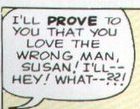
Stan picked up on this again a couple of issue later:
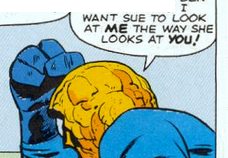
But generally, Stan's dialog simplifies the story, and loses the essential love triangle. If we ignore Stan's writing, and just focus on the art, we see that the love triangle explains all of Ben's anger and depression.
Let's start with issue 2: when Ben is normal, Sue is smiling. When Ben becomes a monster again, Sue does not seem sad or worried, she just seems uninterested: she even avoids eye contact.

In issue 3 Johnny is siding with Reed, the winner in the love
triangle. He seems to be saying "get over it". A Kirby expert once
pointed out that Johnny's position in that middle frame looks odd:
possibly it is redrawn to make it more mocking? Either way, Johnny is
siding with Reed, the man who caused Ben's problem and is now dating
Sue.

Issue 4 is even clearer. Again, ignore the dialog and look at the
art: Sue is siding with Reed, and it drives Ben crazy! I am not saying
that Stan's dialog was completely different from what Jack intended, but
the obvious romantic nuance is completely ignored in the text.
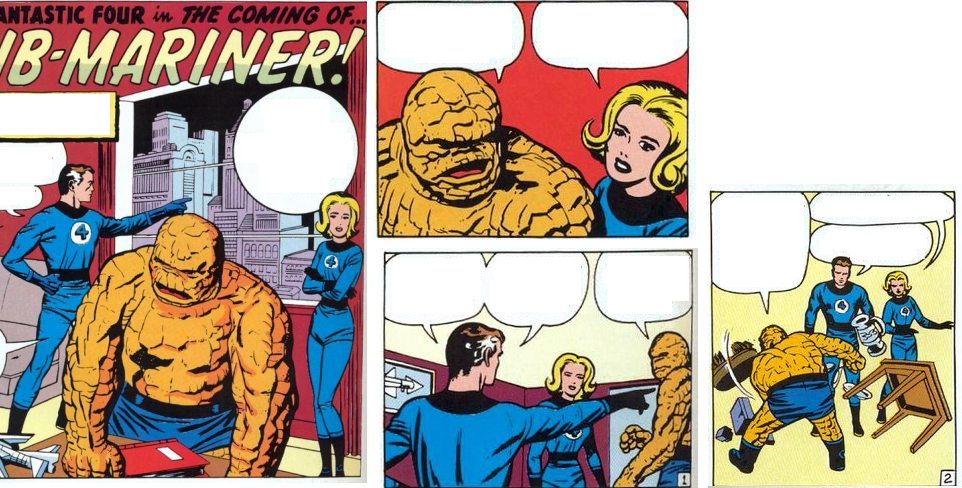
Finally, issue 6 is the clearest example yet: Sue is in another man's
arms and it drives Ben wild! Worse, Ben is restrained by Sue's official
boyfriend!
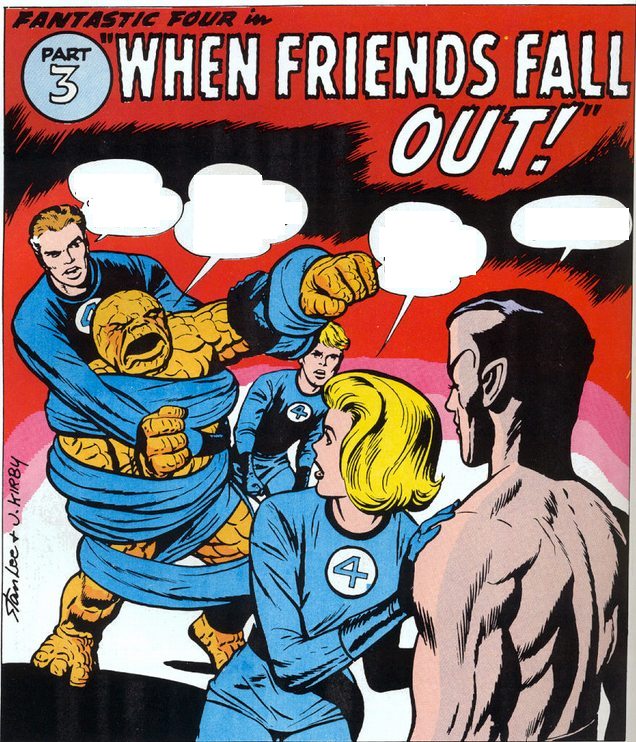
The title, "when friends fall out", was probably drawn in by Kirby. Does it refer to Namor and Doom? No, because they were not friends, and we do not learn that Doom has betrayed Namor until next chapter. This chapter is about them all fighting over Sue.
In FF 8 Ben finally leaves. Sue has sided with Reed, and Ben no
longer wants to be reminded of that every day. Sue asks him to come back, but she
is staying with Reed and Ben just wants out.

In a dramatic twist, later Sue must beg Ben and he is no longer there for her
.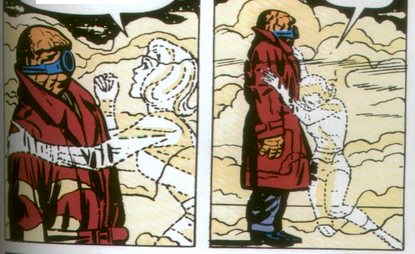
And at the end he finds a girl who looks exactly like Sue. But in a reversal of issue 2's events, this "Sue" loves him as The Thing.
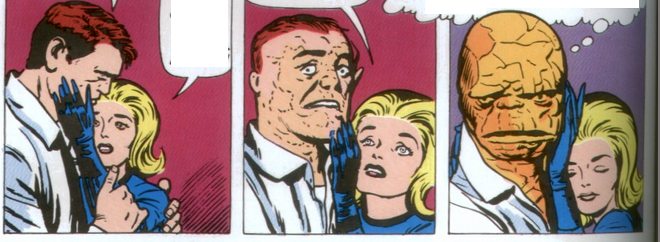
My point is that all of Ben's early anger came from losing Sue. This storyline is natural coming from Kirby: it's a classic romance comic situation, where two men fight over a woman. Kirby literally invented the romance comic (with his partner Joe Simon). Here are two examples of men fighting over a woman in a Kirby comic: different stories from Young Romance 37, written at the same time Kirby was writing Challengers:
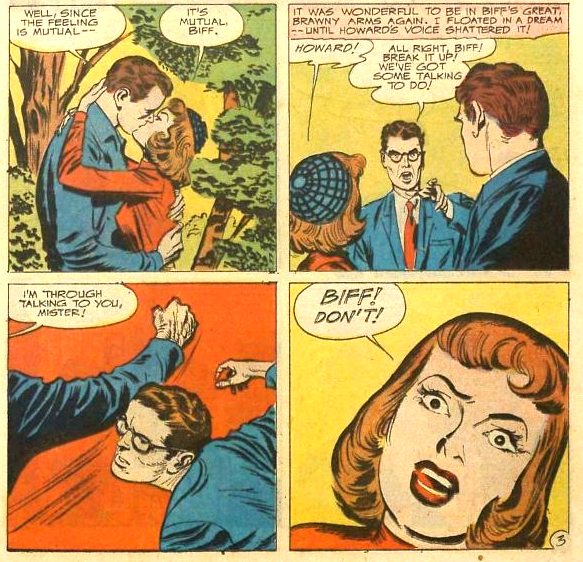
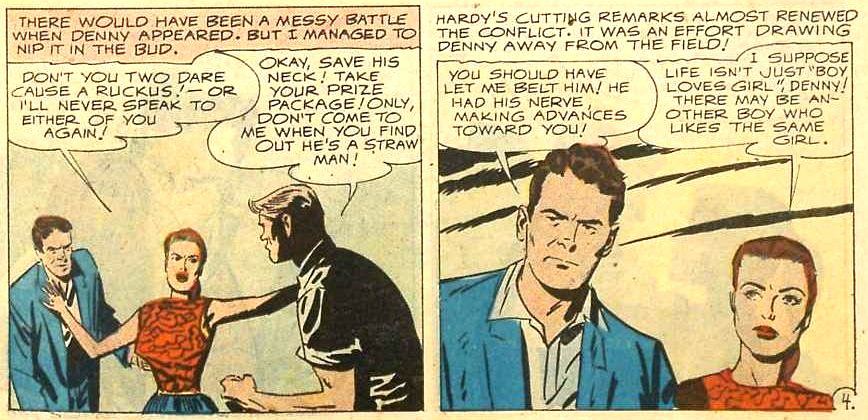
In summary, the angry fighting between team members is classic Kirby,
and arises naturally from the situation (unknown radiation can change
people) that Kirby set up in Challengers.
Fantastic Four issue one contains a number of serious problems. But each of these is resolved when we see FF 1 as a continuation of the Challengers
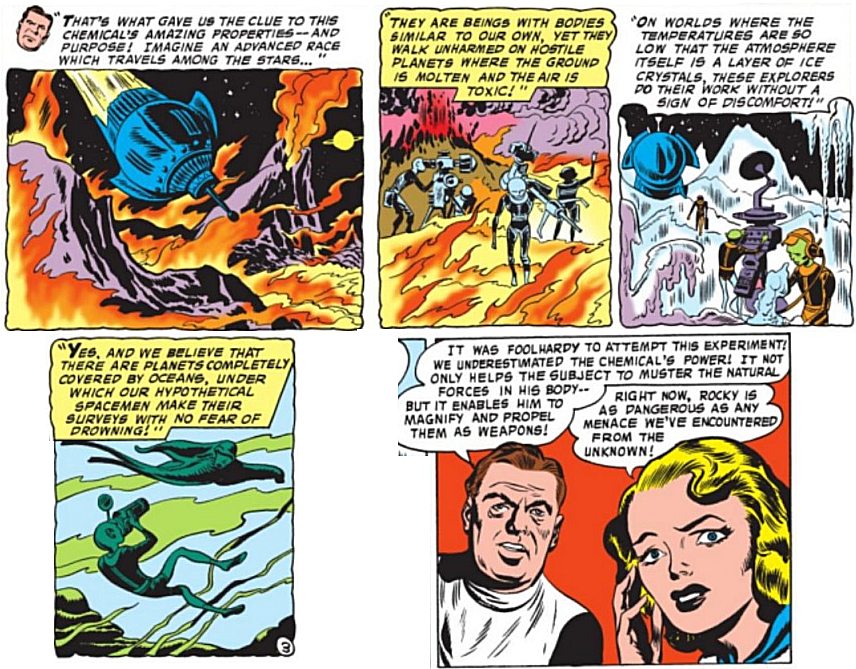
Kirby intended the Fantastic Four to be "a derivative" of the Challengers. That is, based on it. This is from a legal deposition by Jack Kirby's son, Neil Kirby:
Q What information, if any, do you have concerning the creation of The Fantastic Four?
A In discussions with my
father The Fantastic Four basically was a derivative of the, from what
he told me, basically he came up with the idea just as a derivative from
the Challengers of the Unknown that he had done several years earlier.
GROTH: "Can you tell me how you came about creating Challengers of the Unknown?"
KIRBY: "Challengers of the
Unknown was a movie to me. The science fiction pictures were beginning
to break, and I felt that the Challengers of the Unknown were part of
that genre. I began to think about three words which have always puzzled
me: Whatís out there? OK? Whatís out there? I didnít care about the
East Side any more. I didnít care about Earth or anything like that. I
thought, whatís really out there? Then I began to draw characters from
outer space, characters from beneath the earth, characters from anywhere
that we couldnít think of. The Challengers were us contending with
these very strange people. A guy would suddenly make a potion that would
render him into a superman and he would begin knocking down buildings
with his bare fists. How do you contend with a guy like that? How do you
stop him?" (source)
This is important. People sometimes complain that the Challengers don't have distinctive personalities. This is partly true, because they are deliberately blank slates: their purpose is to represent the readers, to see how we would solve a problem. They did not develop distinctive personalities until the Fantastic Four.
The Challengers dealt with radiation and its effects (e.g. in Showcase 6, Challengers 3, Challengers 8, etc.). It is only natural that the next step focused on individual characters.
GROTH: "Looking back on it, do you see the Challengers as a precursor to the Fantastic Four?"
KIRBY: "Yes, there were
always precursors to the Fantastic Four ó except the Fantastic Four were
mutations. When people began talking about the bomb and its possible
effect on human beings, they began talking about mutations because
thatís a distinct possibility. And I said, ďThatís a great idea.Ē Thatís
how the Fantastic Four began, with an atomic explosion [see below] and its effect
on the characters. Ben Grimm who was a college man and a fine looking
man suddenly became the Thing. Susan Storm became invisible because of
the atomic effects on her body. Reed Richards became flexible and became
a character that I could work with in various ways. And there were
others ó mutation effects didnít only affect heroes, it affected
villains too. So I had a grand time with the atomic bomb. [Laughter.]" (source)
The challengers were generic, but the Fantastic Four brought them into focus as individuals with individual differences.
Kirby saw the FF as about the effects of radiation, not the
characters. The characters only became important later, as people grew
used to them.
"The idea for the F.F. was my idea. My own anger against radiation. Radiation was the big subject at that time, because we still donít know what radiation can do to people. [...] The element of truth in the Fantastic Four is the radiationĖ not the characters. And thatís what people relate to, and thatís what we all fight about today.
PITTS: You think people relate more to the radiation aspect than to the characters?
KIRBY: NoÖ Now, they relate to the characters because time has passed and the characters are important." (source)
We see this in the Challengers as well. The second Showcase issue is
about how radiation gave a machine incredible intelligence. In the final
issue (Challengers 8) we see similar radiation from space, again giving super intelligence to robots.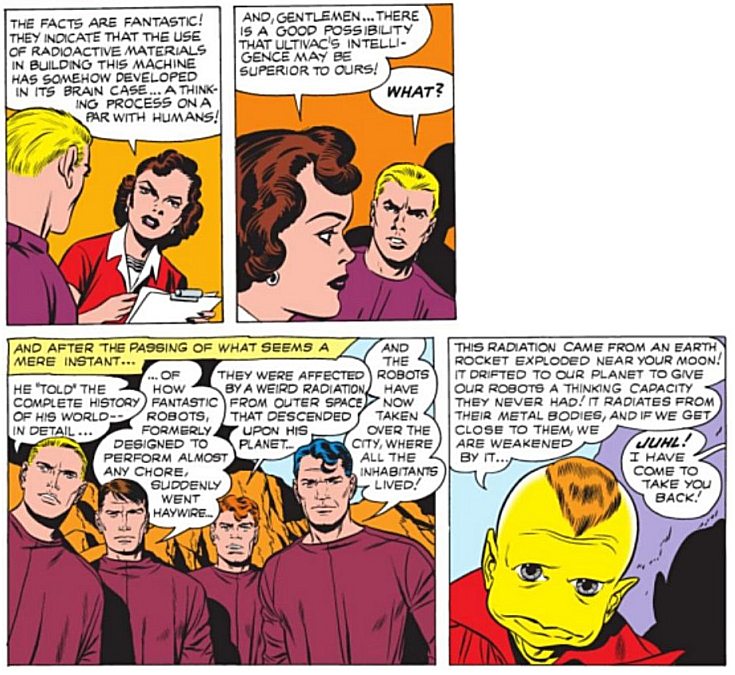
Did you notice that wording in each case? The radiation from space gave FANTASTIC powers.
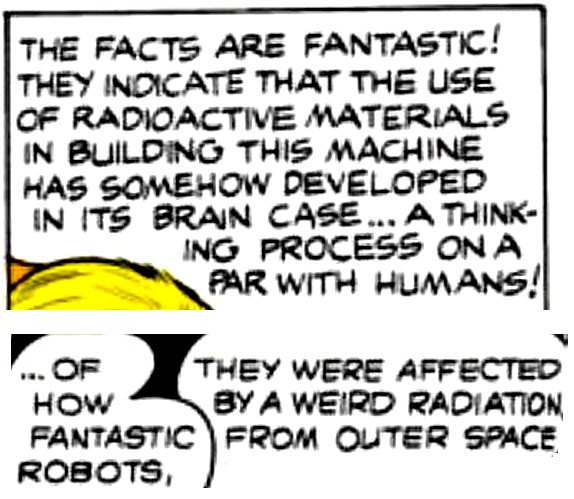
The same word was used to describe the super powered monkey that led to Rocky gaining flame power, invisibility, stretching and strength.
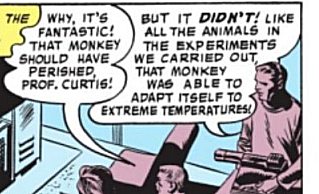
What if all four team member gained these FANTASTIC powers? What would they call themselves?
There is no "correct" way to interpret the Challengers, or any Kirby story:
"I was
presenting my views to the reader and saying 'what do YOU think?' I
think that's an imperative for any writer. In other words, no writer
should feel that he has the last word on any subject. Because he hasn't
got the capacity. He doesn't know! I don't know, see, I'm guessing as
well as you [do], except I may be a little more descriptive, that's all.
[...] I put enough chinks into the story to allow the reader to
interpret it his way. Because I've always respected the reader.
[...] I sold the best stories I could. But I didn't present my stories as the final word."
(source: interview, 14 August 1992, 18 minutes in)
So if we want to say the Challengers become the Fantastic Four, I think Kirby would be perfectly happy with that.
All of this is to show that, In Kirby's mind, the Challengers and the
Fantastic Four were about the same things. The difference is that in
the Fantastic Four the characters were given more detailed
personalities. Now let us look t what we know of the barely defined
Challenger personalities:
Fiction always has gaps. We do not know every detail about a person
and their life, we just see the most interesting parts. This is
especially true of the Challengers: most of their life and characterisation
is not define. The Fantastic Four neatly fills those gaps. For example,
the Challengers does not tell us Red's background. The Fantastic Four
reveals that he is June's brother. Since they are gaps, they could be
filled in other ways. The Challengers would also fit with fan fiction
where Red is no relation to June. There are multiple ways to fill the
gaps! But the Fantastic Four fit very neatly.
The nickname Ace means the same as Mr Fantastic: this guy loves
himself! He worked on the top secret military space program, so "Morgan"
was probably an alias to keep his real name (Richards) private.
"Ace" naturally takes on the role of leader of each team, even though they are in theory equals. His big goal is to enter space. Remember, this was 1958, when America and Russia were racing to be the first in space, and when "the space program" was merely the high altitude part of the air force. In Fantastic Four 1, Ace succeeds. That was 1961, the year when in the real world man also entered space.
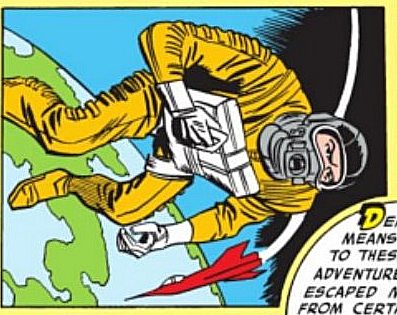
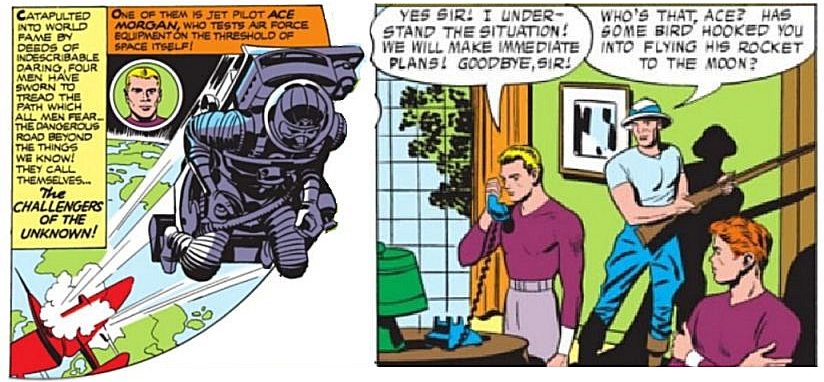
"Ace" looks older and thinner in fantastic Four 1. This is easily explained by the youth serum in the previous issue, Challengers 8.
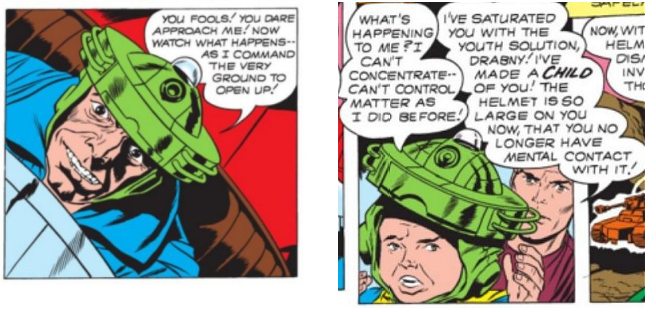
After using the youth serum your age is supposed to return to normal.
But the challengers
are dedicated to exploring the unknown, and repeated use could easily
cause a person's age to rebound too far. But after the first few issues Reed's age did return to Ace's age, and Ace's general appearance, but the grey-ish hair remained.
This is the most obvious parallel. A fighter who calls himself rocky ends up covered in rocks. The Fantastic Four reveals that Rocky was a pilot during the war, and became a test pilot thereafter. This explains how Rocky (Ben) and Ace (Reed) met and became friends. But Reed was far more obsessive about pushing the edge of space, so it looks like Ben chose a second career as a wrestler. In Fantastic Four 15, when the Thinker tries to break up the Fantastic Four, he knows that a return to wrestling is the best way to attract Ben/Rocky. (At first Ben resists, but he is soon persuaded.)
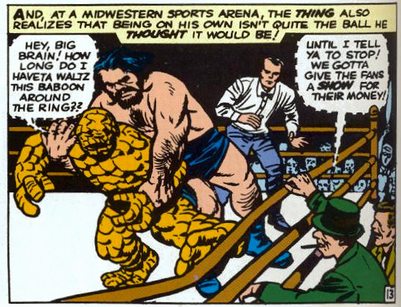
Ryan, the "circus daredevil", is clearly the youngster of the group:
he is always shown as shorter than the others, and the others take the
lead.
World class circus acrobats do have to be young.

Possibly his age was further reduced after experiments with the youth serum.
Johnny Storm comes from a circus family. Here Stan's added dialog implies that Johnny was new to the circus, but Kirby's art says otherwise: his face is relaxed, as if this is familiar territory. I follow Kirby's FF, not Lee's.
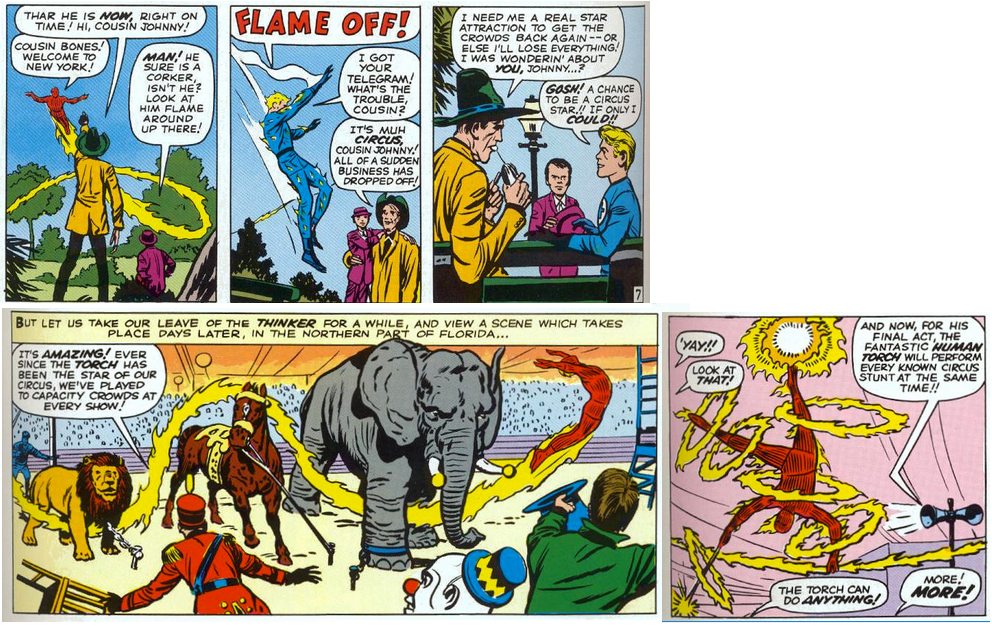
"Red Ryan" sounds like a circus stage name. "Johnny Storm" could also be a code name, but seems to be used as his real name.
Johnny's distinctive hairstyle remains the same. The change from orange to yellow can easily be explained by the comic book printing technology of the time.
June is the less powerful member of the team, and the last to join.
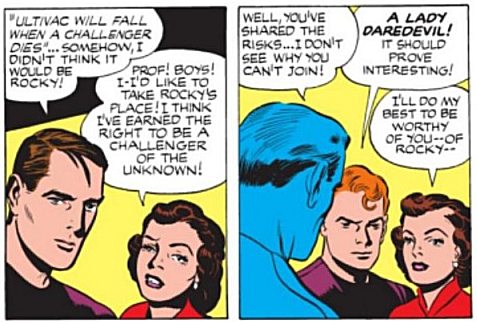
As time goes on, June looks more like Sue. This depends of course on her hairstyle and who is inking: the earlier Fantastic Four inkers were often rushed.
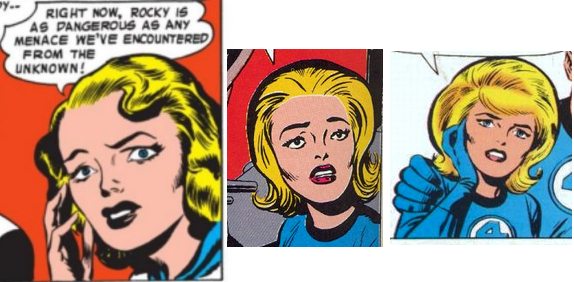
June/Sue is an expert on computers. She is able to short circuit Doom's computer in a second, with her hands tied behind her back.

A cur-off switch does not normally cause a computer to explode!
Clearly she understood exactly how the machine worked. Note that her
skill was in 1950s era computers: this skill became obsolete once the
team gained access to the more advanced computers from planet X in FF 7.
June/Sue makes up for her lack of physical power with her intelligence and bravery. This is often obscured by Stan Lee's dialog, but Kirby's art and plotting makes it clear: June/Sue is a match for any of the boys.
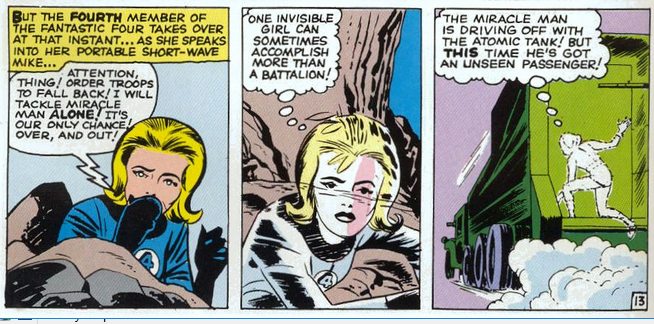
Wen we first meet Sue she is June Robbins. But soon after she is June
Walker and has dyed her hair blonde. This implies a marriage to an
unnamed Mr Walker, and possible insecurity. This insecurity is supported
by her first appearance, where the Challengers are amazed to find a
woman in a demanding role: she has to fight 1950s sexism all the time.
We don't know "Mr Walker", but "Patsy Walker" appeared in FF annual 3,
and had a large extended family in her own comic. Patsy began in "Miss
America" magazine in the early 1940s, published by Timely when Kirby was
working there, so he was familiar with the name. Here for example is
Patsy's younger brother, Michael Walker, who would certainly be old
enough to marry June Robbins in 1958. Of course, June could have married a different Walker.
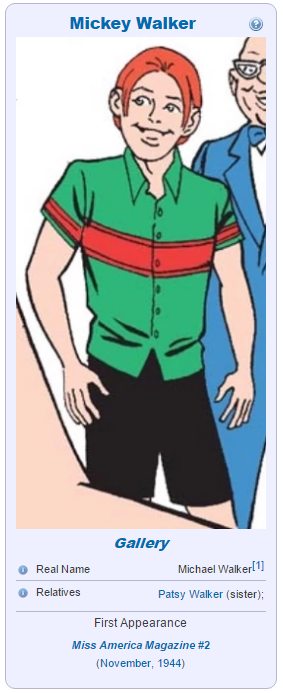
So we can read between
the lines: Sue/June had a failed marriage to one of the Walker clan.
This explains why she was not romantically interested in the
Challengers, despite them being the most alpha of alpha males, and her
having so much in common (becoming an honorary challenger due to her own
skills).
No doubt meeting the challengers contributed to her failed marriage:
in Challengers 2 she would have been engaged to one of the Patsy Walker
family, not known for their high intellect. The Challengers were clearly
her soul mates - how could she be happy married to one of dizzy Patsy's
family? She had made a terrible mistake. We don't know the details of
the divorce, she is clearly a very private person, but once divorced she
was free to become romantically involved again. Ace and Rocky were the
natural leaders of the pack, but who would she choose?
Of all the team member, Professor Haley seems least at ease. He is the odd one out, using his title and real name. When the others look excited and interested, Haley seems cautious or uncomfortable. When the others love action and fighting, Haley prefers to study his books, and the relative silence and peace of the oceans. Once June had joined the team it is natural that Professor Haley would retire.
Professor Haley is the perfect person to uncover the mysteries of the
oceans. It is tempting to imagine him being involved in the discovery
of Prince Namor. Was it really an accident? Who is the skinny man with
limp hair who was
always nearby, hidden by a wide brimmed hat? :)
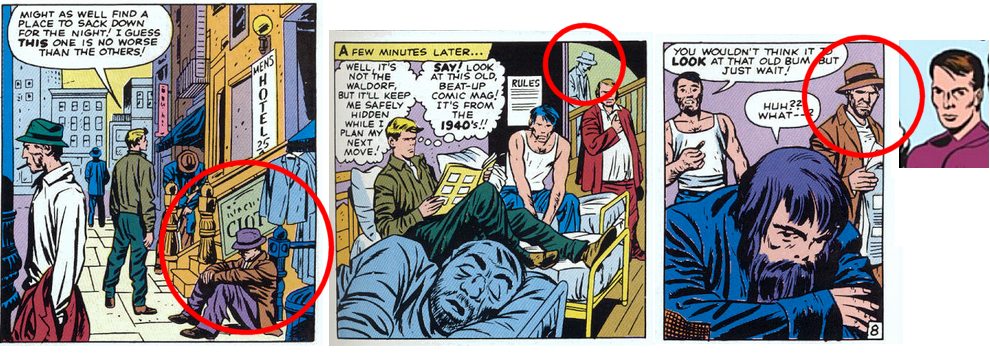
The Challengers explains the origin of the team's super powers: aliens use a specially designed liquid to heighten their abilities as needed. An ancient humans civilisation managed to create a crude version that could (at least) turn people into giants. Sorcerers down the ages have managed to create simpler versions with limited abilities, e.g. making a person's body young. But they are clearly variations on the same liquid. Note how the de-aging liquid is in the form of a mist: the Inhumans also used a mist to change their DNA.

Has that caught your interest? Good!
Coming soon: an issue by issue review!
In the story, Reed has his own seismograph.
At the time, thanks to the 1958 Geneva Convention, there was a network of 150 seismograph stations dotted around the world, designed to detect atomic tests.
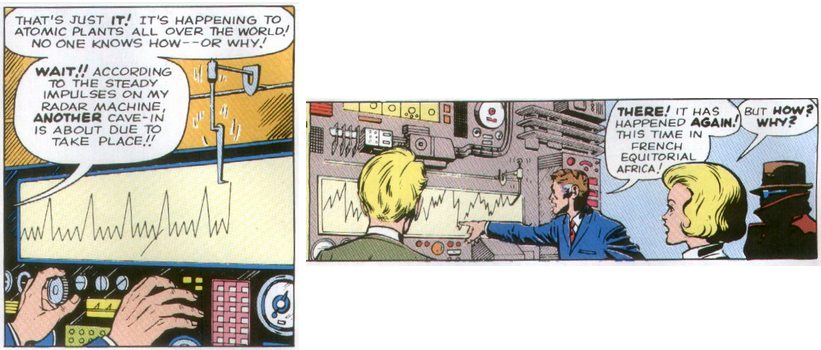
Bomb tests often took place underground, and no doubt this was why the Mole Man destroyed nuclear plants in revenge.
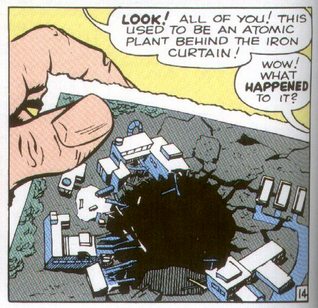
The story ends when Reed or the Torch sets off an atomic explosion.
The dialog says the Mole Man did it, but that makes no sense: why blow
up your own house? The art seems to indicate that Reed set off a bomb
after Johnny sealed the entrance. This is confirmed by the Mole Man's
dialog when they next return: Reed set off the bomb.
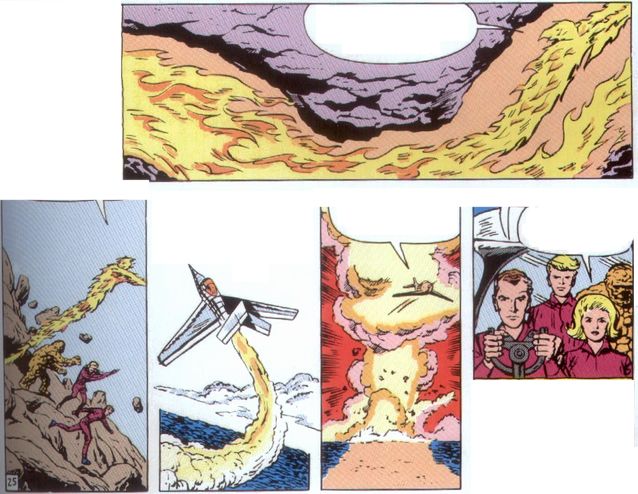
How does this link to outer space? In the Challengers stories, mutations were caused by radiation in space, and that radiation got there due to man-made bombs:

Where did this idea come from? In 1958, when Kirby was writing Challengers, the Americans had just discovered the Van Allen radiation belts.
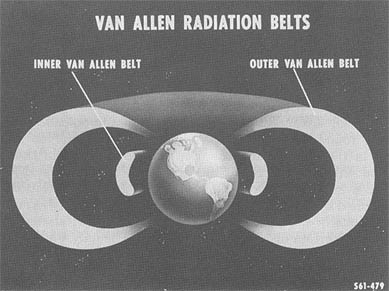
They were planning to explode a hydrogen bomb in space to understand how they interact. The plan wasned explosion eventually took place in 1962, producing a spectacular light show. Click the link for details, or Google "Starfish Prime"
So when the Fantastic Four entered the Van Allen radiation belts above Earth it was just as Kirby said: it was linked to man's experiments with the atom bomb, and humans did not know what that radiation would do.
